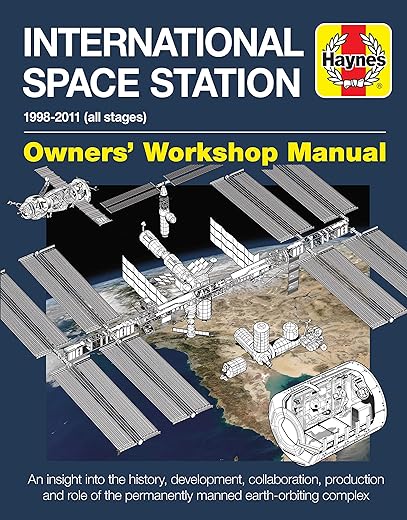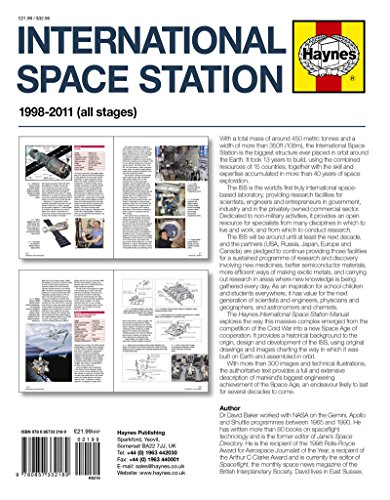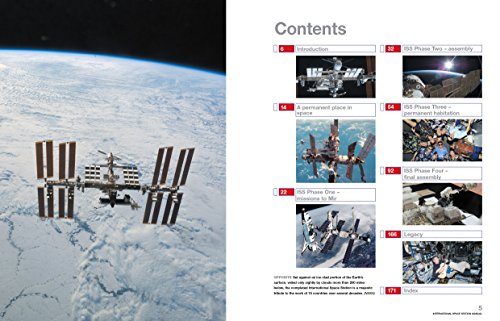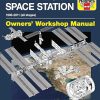International Space Station Manual (New Ed): 1998–2011 (all stages) (Owners’ Workshop Manual)
£19.30£23.80 (-19%)
The International Space Station (ISS) is a permanently manned earth-orbiting complex where astronauts carry out research into a wide range of scientific activities. It comprises modules built in the USA, Russia, Europe, Japan and Canada. Author David Baker examines how the ISS was built, the logistics modules and freighters operated by its user nations, how the ISS works as an integrated facility, life on board, what the ISS does, the research carried out and who benefits.
Read more
Additional information
| Publisher | J H Haynes & Co Ltd, Reprint edition (30 May 2015) |
|---|---|
| Language | English |
| Hardcover | 168 pages |
| ISBN-10 | 0857338390 |
| ISBN-13 | 978-0857338396 |
| Dimensions | 21.59 x 1.27 x 27.94 cm |












by Mr. R. E. J. Hyson
As a non-engineer, but a great fan of spaceflight, I found this book a little heavy going (in fact I just skimmed through it). I suppose the original Haynes Workshop Manuals were originally written for engineers, and this falls well into that category. I’m afraid the limited space remaining on my bookshelves will have to remain empty for a while longer.
by markandhev
Bought this for my space mad 13 yr old son – having had a good flick through it, feel its the right balance between text and pictures, therefore an accessible read for him. He says he’s pleased with it, so will plan to buy others in the series for future birthdays, etc.
by carol
Great reading and gives great detailed information about the subject
by debbbbi
Perfect
by Michael Littlechild
Sons birthday present gone to nz
by VS
And this one is no exception. Good quality pictures and explanations that are easy enough to understand for a non-engineer.
by Brendan Purcell
If you are familiar with David Baker’s other Haynes books, you’ll be broadly aware of his style of writing. Once again, we have a book that is a heavy read.
First off, the book almost reads as a diary. There’s 134 pages of a mission by mission synopsis of the trips to assemble the ISS, and it suffers from a number of problems that are common to most of Mr. Baker’s books:
– The book misses the point. While the history leading up to its construction via Mir and Skylab is well written by being concise and contextual, the main body of the book is the opposite. By taking a mission approach, technical explanation doesn’t happen too well. If he’d changed to having chapters on 1) Overall Design, 2) Assembly, 3) Operation 4) Maintenance and 5) Science Experiments it woud have moved away from being a diary to being a more structured engineering oversight.
– The text is full on, he throws loads of details at you in a very short space of time and it very hard to keep up with it all. I sometimes suspect that the book is formed from other materials prepared for other audiences.
– For a Haynes book, there is detail in areas that are not technically relevent (e.g. do we need to be constantly told the duration in space of individuals and vehicles). On the flip side, deeper dives into technical matters are scant (e.g. how exactly does the Canadarm grapple work; how is strucural rigidity ensured; what’s the incremental design review process; how does micrometeorite protection work over long periods?).
– There are superb pictures which generally are well syrchronised with the text, however they are pasted in without specific parts being highlighted – and some are too small to read. A few arrows or circles to clearly identify parts would be hugely beneficial.
In short, this is another Baker book that needed a heavier hand from Haynes in terms of structure and editing.
by Nikolai Leon
Christmas Present for 9 year old